Finance Assignment: Capital Budgeting, Valuation, and Risk Analysis
VerifiedAdded on 2020/06/04
|17
|2051
|145
Homework Assignment
AI Summary
This finance assignment solution provides a detailed analysis of various financial concepts. It begins with an overview of funding sources, including equity, preference shares, and debt capital, and their respective advantages and disadvantages. The assignment then delves into the analysis of financial instruments, including futures contracts, and option valuation. It further explores the computation of expected return and standard deviation for common stocks, as well as the calculation of the required rate of return using the CAPM model. The core of the assignment focuses on capital budgeting techniques, such as payback period, discounted payback period, net present value (NPV), profitability index, internal rate of return (IRR), and modified internal rate of return (MIRR). The solution also addresses capital rationing, project selection, and the problems associated with it. Finally, it compares projects using replacement chains and equivalent annual annuity (EAA) to determine the most financially viable investment options, providing a comprehensive understanding of financial decision-making.
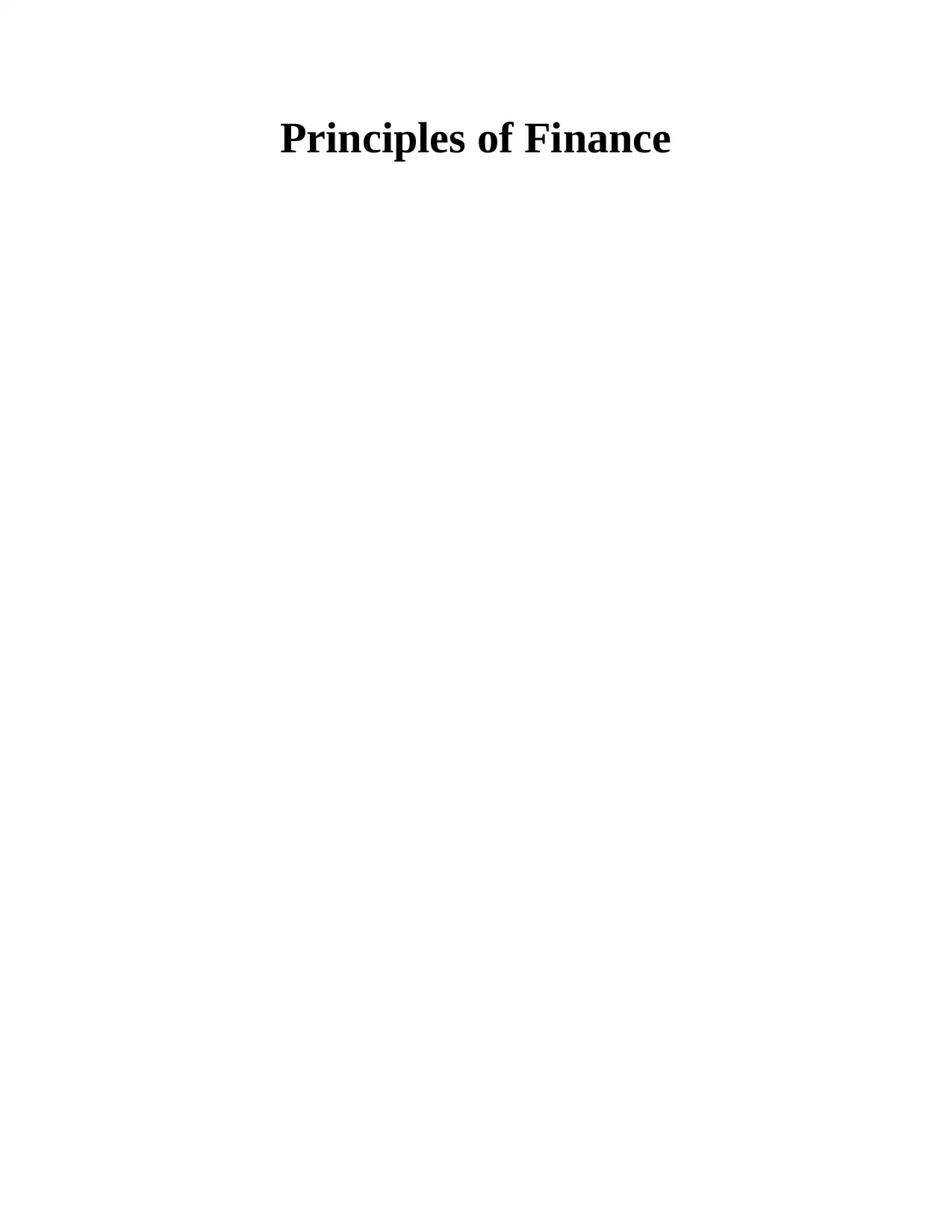
Principles of Finance
Paraphrase This Document
Need a fresh take? Get an instant paraphrase of this document with our AI Paraphraser
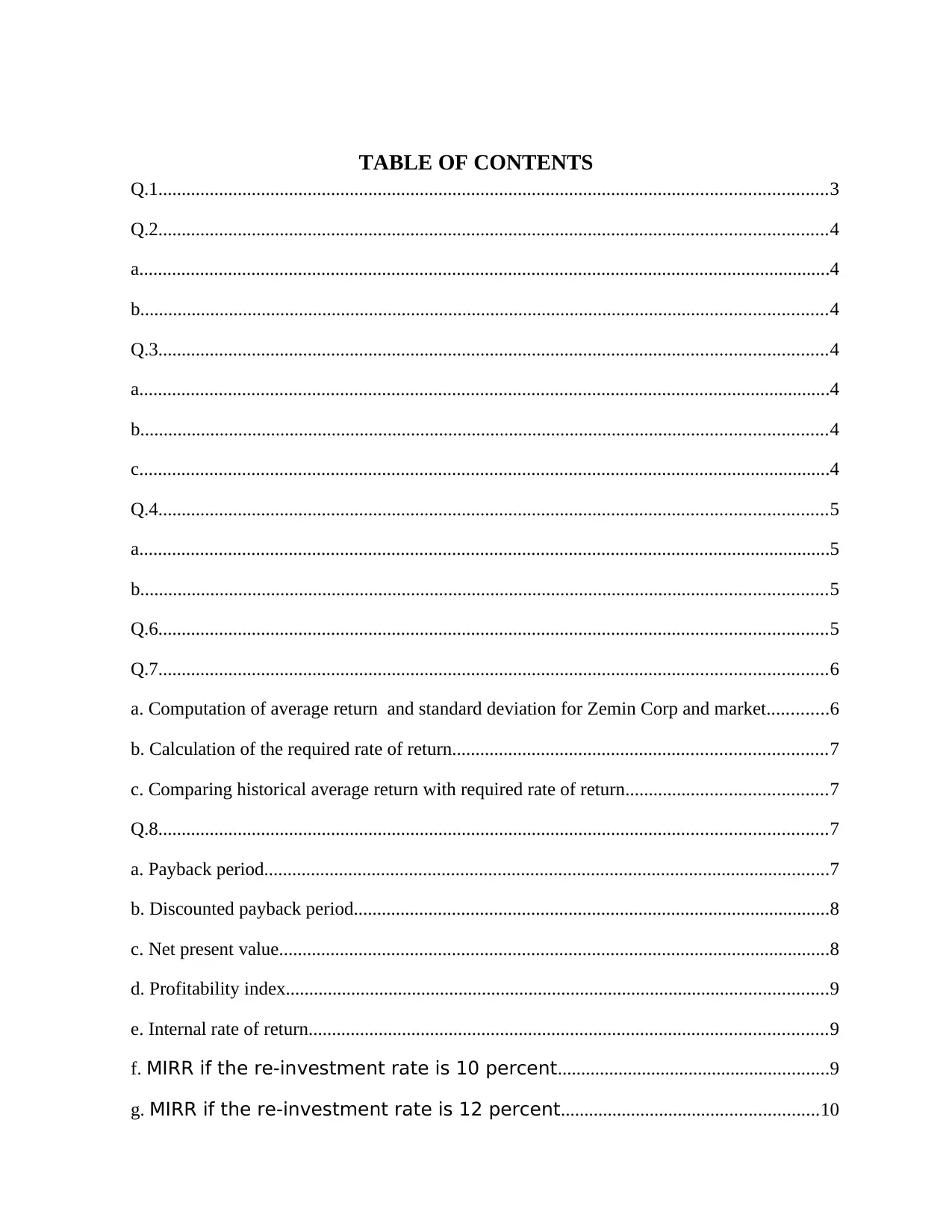
TABLE OF CONTENTS
Q.1...............................................................................................................................................3
Q.2...............................................................................................................................................4
a....................................................................................................................................................4
b...................................................................................................................................................4
Q.3...............................................................................................................................................4
a....................................................................................................................................................4
b...................................................................................................................................................4
c....................................................................................................................................................4
Q.4...............................................................................................................................................5
a....................................................................................................................................................5
b...................................................................................................................................................5
Q.6...............................................................................................................................................5
Q.7...............................................................................................................................................6
a. Computation of average return and standard deviation for Zemin Corp and market.............6
b. Calculation of the required rate of return................................................................................7
c. Comparing historical average return with required rate of return...........................................7
Q.8...............................................................................................................................................7
a. Payback period.........................................................................................................................7
b. Discounted payback period......................................................................................................8
c. Net present value......................................................................................................................8
d. Profitability index....................................................................................................................9
e. Internal rate of return...............................................................................................................9
f. MIRR if the re-investment rate is 10 percent..........................................................9
g. MIRR if the re-investment rate is 12 percent.......................................................10
Q.1...............................................................................................................................................3
Q.2...............................................................................................................................................4
a....................................................................................................................................................4
b...................................................................................................................................................4
Q.3...............................................................................................................................................4
a....................................................................................................................................................4
b...................................................................................................................................................4
c....................................................................................................................................................4
Q.4...............................................................................................................................................5
a....................................................................................................................................................5
b...................................................................................................................................................5
Q.6...............................................................................................................................................5
Q.7...............................................................................................................................................6
a. Computation of average return and standard deviation for Zemin Corp and market.............6
b. Calculation of the required rate of return................................................................................7
c. Comparing historical average return with required rate of return...........................................7
Q.8...............................................................................................................................................7
a. Payback period.........................................................................................................................7
b. Discounted payback period......................................................................................................8
c. Net present value......................................................................................................................8
d. Profitability index....................................................................................................................9
e. Internal rate of return...............................................................................................................9
f. MIRR if the re-investment rate is 10 percent..........................................................9
g. MIRR if the re-investment rate is 12 percent.......................................................10
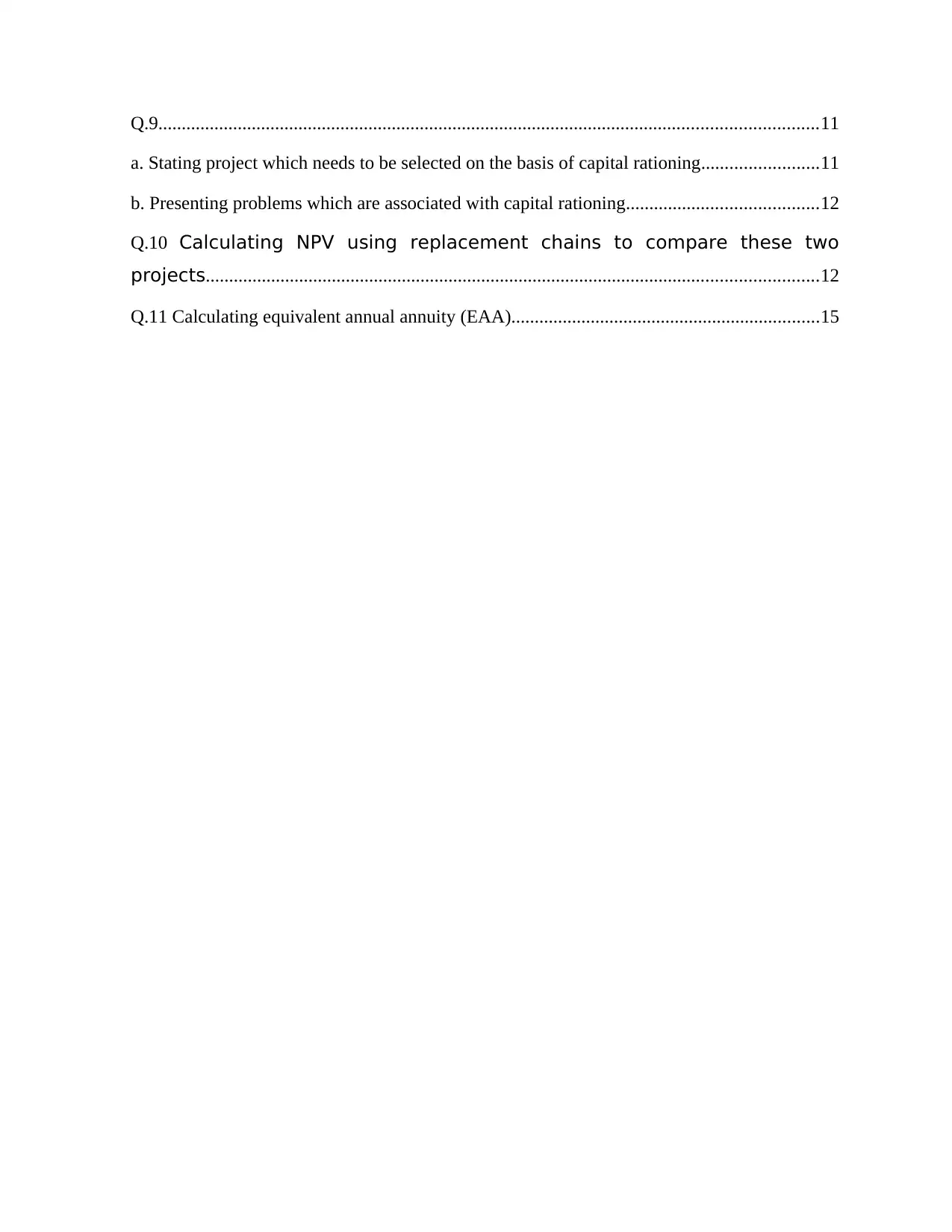
Q.9.............................................................................................................................................11
a. Stating project which needs to be selected on the basis of capital rationing.........................11
b. Presenting problems which are associated with capital rationing.........................................12
Q.10 Calculating NPV using replacement chains to compare these two
projects...................................................................................................................................12
Q.11 Calculating equivalent annual annuity (EAA)..................................................................15
a. Stating project which needs to be selected on the basis of capital rationing.........................11
b. Presenting problems which are associated with capital rationing.........................................12
Q.10 Calculating NPV using replacement chains to compare these two
projects...................................................................................................................................12
Q.11 Calculating equivalent annual annuity (EAA)..................................................................15
⊘ This is a preview!⊘
Do you want full access?
Subscribe today to unlock all pages.

Trusted by 1+ million students worldwide
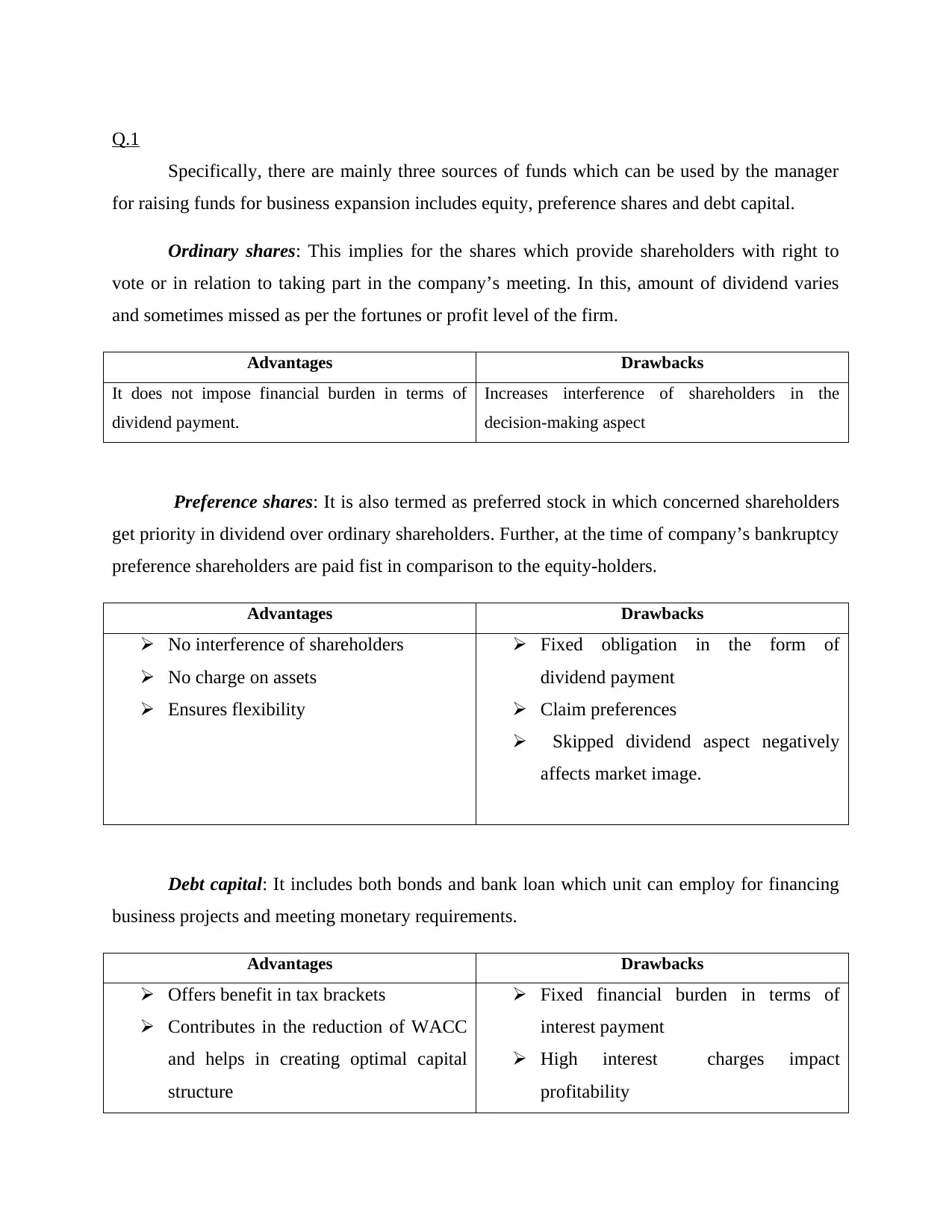
Q.1
Specifically, there are mainly three sources of funds which can be used by the manager
for raising funds for business expansion includes equity, preference shares and debt capital.
Ordinary shares: This implies for the shares which provide shareholders with right to
vote or in relation to taking part in the company’s meeting. In this, amount of dividend varies
and sometimes missed as per the fortunes or profit level of the firm.
Advantages Drawbacks
It does not impose financial burden in terms of
dividend payment.
Increases interference of shareholders in the
decision-making aspect
Preference shares: It is also termed as preferred stock in which concerned shareholders
get priority in dividend over ordinary shareholders. Further, at the time of company’s bankruptcy
preference shareholders are paid fist in comparison to the equity-holders.
Advantages Drawbacks
No interference of shareholders
No charge on assets
Ensures flexibility
Fixed obligation in the form of
dividend payment
Claim preferences
Skipped dividend aspect negatively
affects market image.
Debt capital: It includes both bonds and bank loan which unit can employ for financing
business projects and meeting monetary requirements.
Advantages Drawbacks
Offers benefit in tax brackets
Contributes in the reduction of WACC
and helps in creating optimal capital
structure
Fixed financial burden in terms of
interest payment
High interest charges impact
profitability
Specifically, there are mainly three sources of funds which can be used by the manager
for raising funds for business expansion includes equity, preference shares and debt capital.
Ordinary shares: This implies for the shares which provide shareholders with right to
vote or in relation to taking part in the company’s meeting. In this, amount of dividend varies
and sometimes missed as per the fortunes or profit level of the firm.
Advantages Drawbacks
It does not impose financial burden in terms of
dividend payment.
Increases interference of shareholders in the
decision-making aspect
Preference shares: It is also termed as preferred stock in which concerned shareholders
get priority in dividend over ordinary shareholders. Further, at the time of company’s bankruptcy
preference shareholders are paid fist in comparison to the equity-holders.
Advantages Drawbacks
No interference of shareholders
No charge on assets
Ensures flexibility
Fixed obligation in the form of
dividend payment
Claim preferences
Skipped dividend aspect negatively
affects market image.
Debt capital: It includes both bonds and bank loan which unit can employ for financing
business projects and meeting monetary requirements.
Advantages Drawbacks
Offers benefit in tax brackets
Contributes in the reduction of WACC
and helps in creating optimal capital
structure
Fixed financial burden in terms of
interest payment
High interest charges impact
profitability
Paraphrase This Document
Need a fresh take? Get an instant paraphrase of this document with our AI Paraphraser
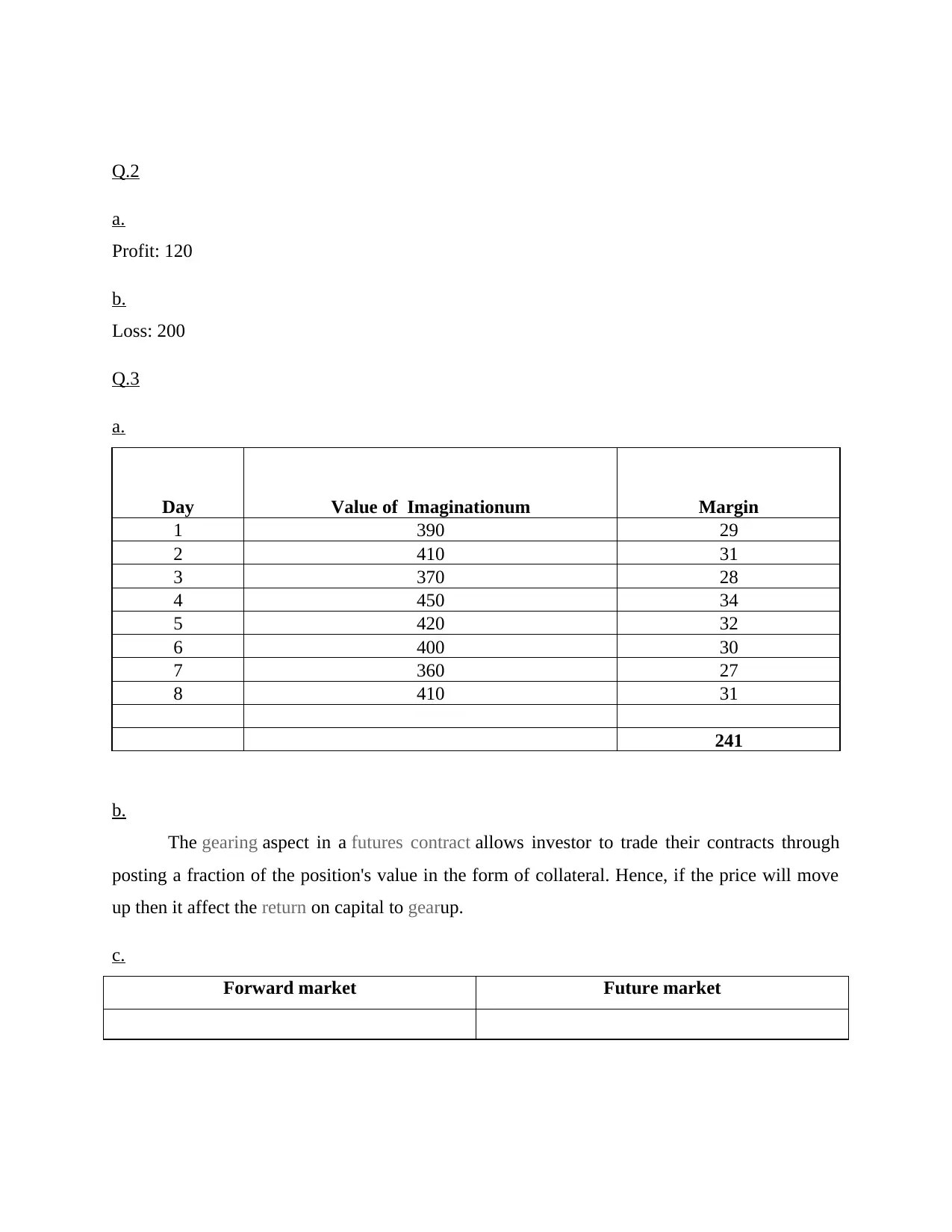
Q.2
a.
Profit: 120
b.
Loss: 200
Q.3
a.
Day Value of Imaginationum Margin
1 390 29
2 410 31
3 370 28
4 450 34
5 420 32
6 400 30
7 360 27
8 410 31
241
b.
The gearing aspect in a futures contract allows investor to trade their contracts through
posting a fraction of the position's value in the form of collateral. Hence, if the price will move
up then it affect the return on capital to gearup.
c.
Forward market Future market
a.
Profit: 120
b.
Loss: 200
Q.3
a.
Day Value of Imaginationum Margin
1 390 29
2 410 31
3 370 28
4 450 34
5 420 32
6 400 30
7 360 27
8 410 31
241
b.
The gearing aspect in a futures contract allows investor to trade their contracts through
posting a fraction of the position's value in the form of collateral. Hence, if the price will move
up then it affect the return on capital to gearup.
c.
Forward market Future market
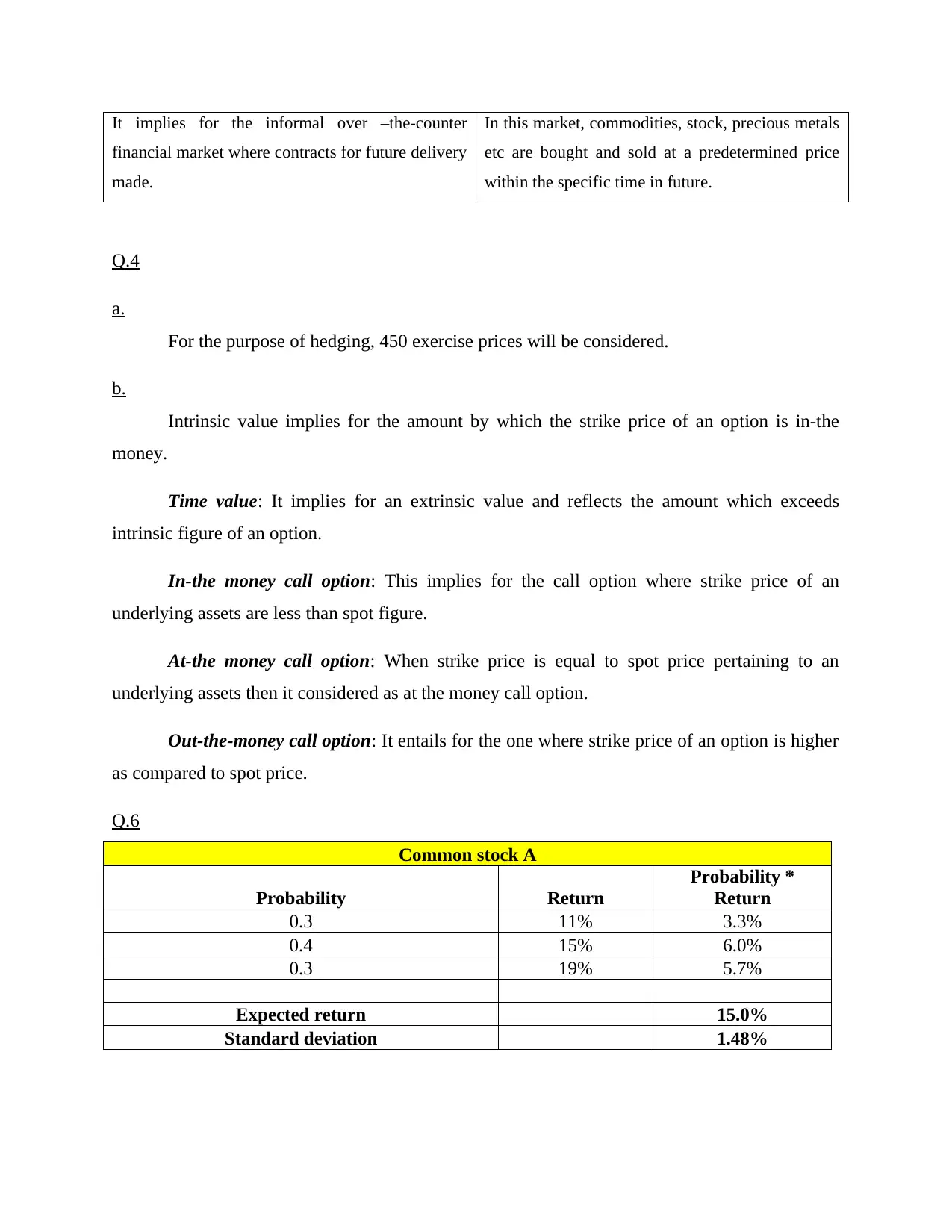
It implies for the informal over –the-counter
financial market where contracts for future delivery
made.
In this market, commodities, stock, precious metals
etc are bought and sold at a predetermined price
within the specific time in future.
Q.4
a.
For the purpose of hedging, 450 exercise prices will be considered.
b.
Intrinsic value implies for the amount by which the strike price of an option is in-the
money.
Time value: It implies for an extrinsic value and reflects the amount which exceeds
intrinsic figure of an option.
In-the money call option: This implies for the call option where strike price of an
underlying assets are less than spot figure.
At-the money call option: When strike price is equal to spot price pertaining to an
underlying assets then it considered as at the money call option.
Out-the-money call option: It entails for the one where strike price of an option is higher
as compared to spot price.
Q.6
Common stock A
Probability Return
Probability *
Return
0.3 11% 3.3%
0.4 15% 6.0%
0.3 19% 5.7%
Expected return 15.0%
Standard deviation 1.48%
financial market where contracts for future delivery
made.
In this market, commodities, stock, precious metals
etc are bought and sold at a predetermined price
within the specific time in future.
Q.4
a.
For the purpose of hedging, 450 exercise prices will be considered.
b.
Intrinsic value implies for the amount by which the strike price of an option is in-the
money.
Time value: It implies for an extrinsic value and reflects the amount which exceeds
intrinsic figure of an option.
In-the money call option: This implies for the call option where strike price of an
underlying assets are less than spot figure.
At-the money call option: When strike price is equal to spot price pertaining to an
underlying assets then it considered as at the money call option.
Out-the-money call option: It entails for the one where strike price of an option is higher
as compared to spot price.
Q.6
Common stock A
Probability Return
Probability *
Return
0.3 11% 3.3%
0.4 15% 6.0%
0.3 19% 5.7%
Expected return 15.0%
Standard deviation 1.48%
⊘ This is a preview!⊘
Do you want full access?
Subscribe today to unlock all pages.

Trusted by 1+ million students worldwide
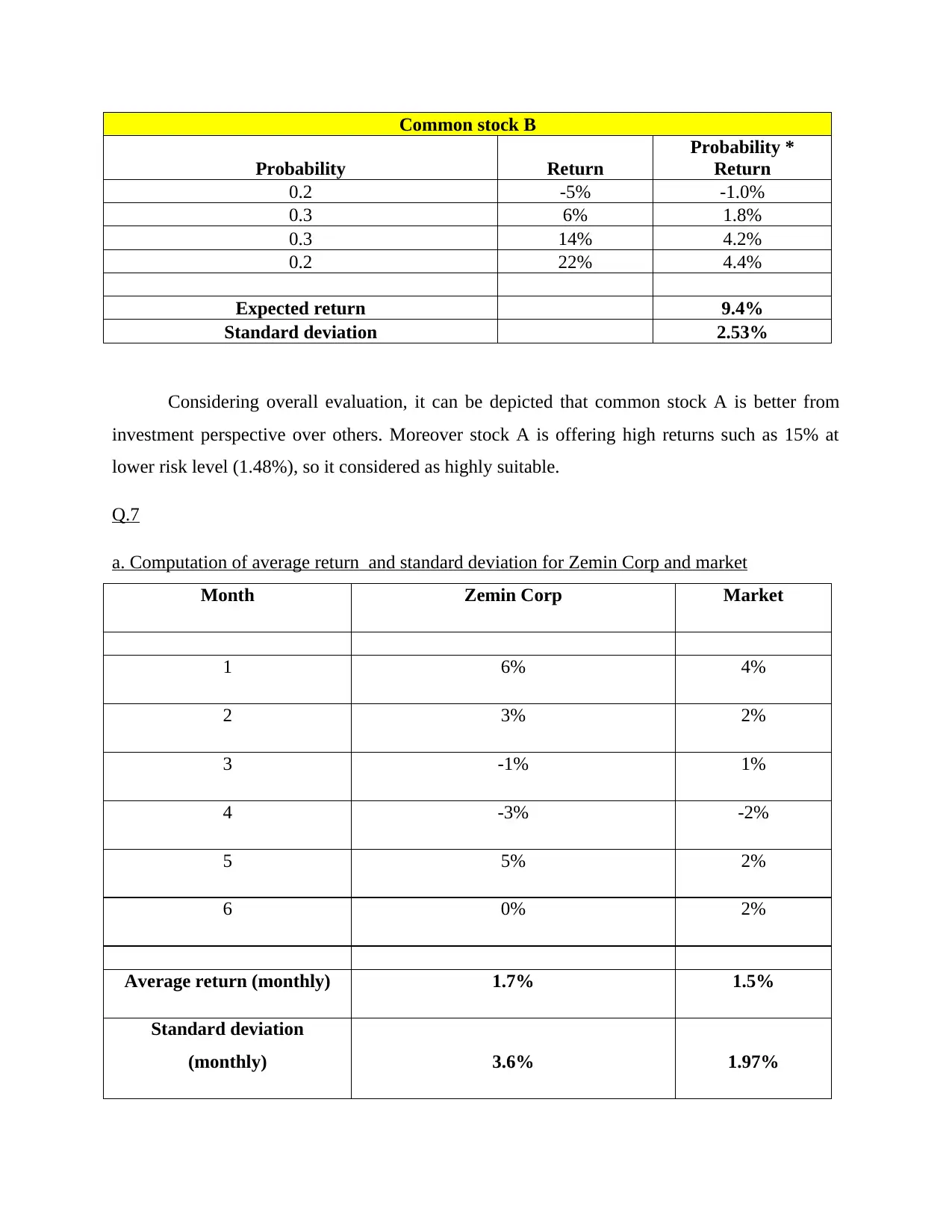
Common stock B
Probability Return
Probability *
Return
0.2 -5% -1.0%
0.3 6% 1.8%
0.3 14% 4.2%
0.2 22% 4.4%
Expected return 9.4%
Standard deviation 2.53%
Considering overall evaluation, it can be depicted that common stock A is better from
investment perspective over others. Moreover stock A is offering high returns such as 15% at
lower risk level (1.48%), so it considered as highly suitable.
Q.7
a. Computation of average return and standard deviation for Zemin Corp and market
Month Zemin Corp Market
1 6% 4%
2 3% 2%
3 -1% 1%
4 -3% -2%
5 5% 2%
6 0% 2%
Average return (monthly) 1.7% 1.5%
Standard deviation
(monthly) 3.6% 1.97%
Probability Return
Probability *
Return
0.2 -5% -1.0%
0.3 6% 1.8%
0.3 14% 4.2%
0.2 22% 4.4%
Expected return 9.4%
Standard deviation 2.53%
Considering overall evaluation, it can be depicted that common stock A is better from
investment perspective over others. Moreover stock A is offering high returns such as 15% at
lower risk level (1.48%), so it considered as highly suitable.
Q.7
a. Computation of average return and standard deviation for Zemin Corp and market
Month Zemin Corp Market
1 6% 4%
2 3% 2%
3 -1% 1%
4 -3% -2%
5 5% 2%
6 0% 2%
Average return (monthly) 1.7% 1.5%
Standard deviation
(monthly) 3.6% 1.97%
Paraphrase This Document
Need a fresh take? Get an instant paraphrase of this document with our AI Paraphraser
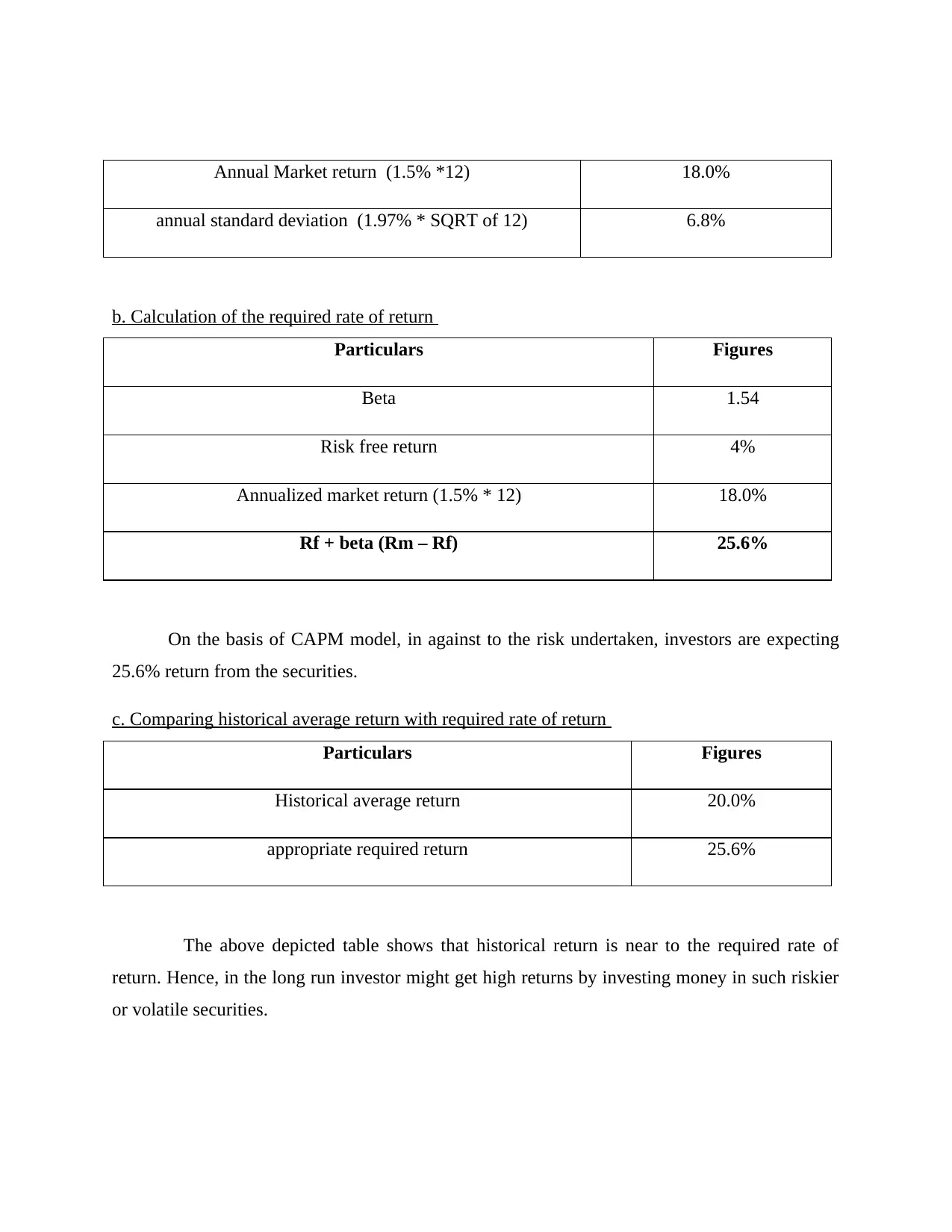
Annual Market return (1.5% *12) 18.0%
annual standard deviation (1.97% * SQRT of 12) 6.8%
b. Calculation of the required rate of return
Particulars Figures
Beta 1.54
Risk free return 4%
Annualized market return (1.5% * 12) 18.0%
Rf + beta (Rm – Rf) 25.6%
On the basis of CAPM model, in against to the risk undertaken, investors are expecting
25.6% return from the securities.
c. Comparing historical average return with required rate of return
Particulars Figures
Historical average return 20.0%
appropriate required return 25.6%
The above depicted table shows that historical return is near to the required rate of
return. Hence, in the long run investor might get high returns by investing money in such riskier
or volatile securities.
annual standard deviation (1.97% * SQRT of 12) 6.8%
b. Calculation of the required rate of return
Particulars Figures
Beta 1.54
Risk free return 4%
Annualized market return (1.5% * 12) 18.0%
Rf + beta (Rm – Rf) 25.6%
On the basis of CAPM model, in against to the risk undertaken, investors are expecting
25.6% return from the securities.
c. Comparing historical average return with required rate of return
Particulars Figures
Historical average return 20.0%
appropriate required return 25.6%
The above depicted table shows that historical return is near to the required rate of
return. Hence, in the long run investor might get high returns by investing money in such riskier
or volatile securities.
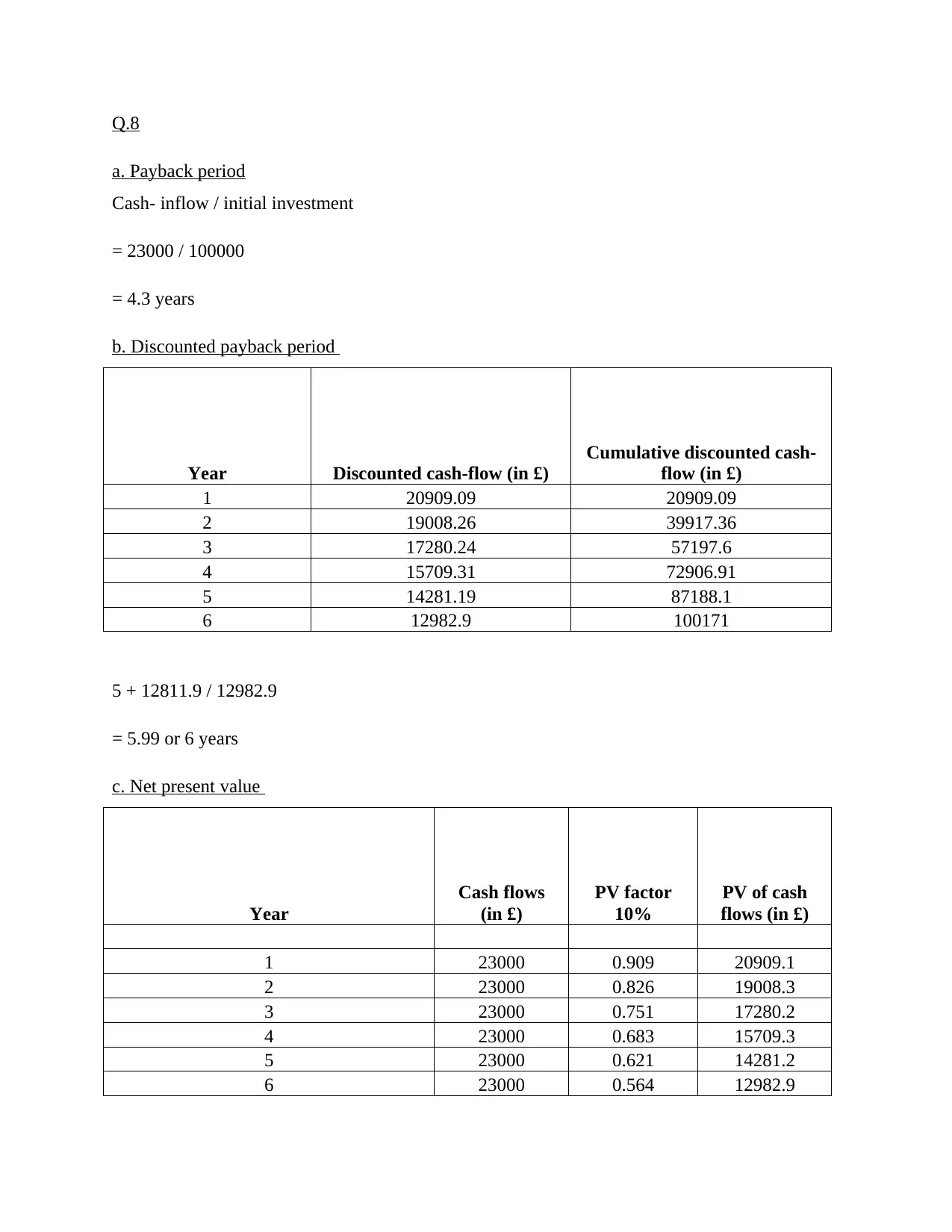
Q.8
a. Payback period
Cash- inflow / initial investment
= 23000 / 100000
= 4.3 years
b. Discounted payback period
Year Discounted cash-flow (in £)
Cumulative discounted cash-
flow (in £)
1 20909.09 20909.09
2 19008.26 39917.36
3 17280.24 57197.6
4 15709.31 72906.91
5 14281.19 87188.1
6 12982.9 100171
5 + 12811.9 / 12982.9
= 5.99 or 6 years
c. Net present value
Year
Cash flows
(in £)
PV factor
10%
PV of cash
flows (in £)
1 23000 0.909 20909.1
2 23000 0.826 19008.3
3 23000 0.751 17280.2
4 23000 0.683 15709.3
5 23000 0.621 14281.2
6 23000 0.564 12982.9
a. Payback period
Cash- inflow / initial investment
= 23000 / 100000
= 4.3 years
b. Discounted payback period
Year Discounted cash-flow (in £)
Cumulative discounted cash-
flow (in £)
1 20909.09 20909.09
2 19008.26 39917.36
3 17280.24 57197.6
4 15709.31 72906.91
5 14281.19 87188.1
6 12982.9 100171
5 + 12811.9 / 12982.9
= 5.99 or 6 years
c. Net present value
Year
Cash flows
(in £)
PV factor
10%
PV of cash
flows (in £)
1 23000 0.909 20909.1
2 23000 0.826 19008.3
3 23000 0.751 17280.2
4 23000 0.683 15709.3
5 23000 0.621 14281.2
6 23000 0.564 12982.9
⊘ This is a preview!⊘
Do you want full access?
Subscribe today to unlock all pages.

Trusted by 1+ million students worldwide
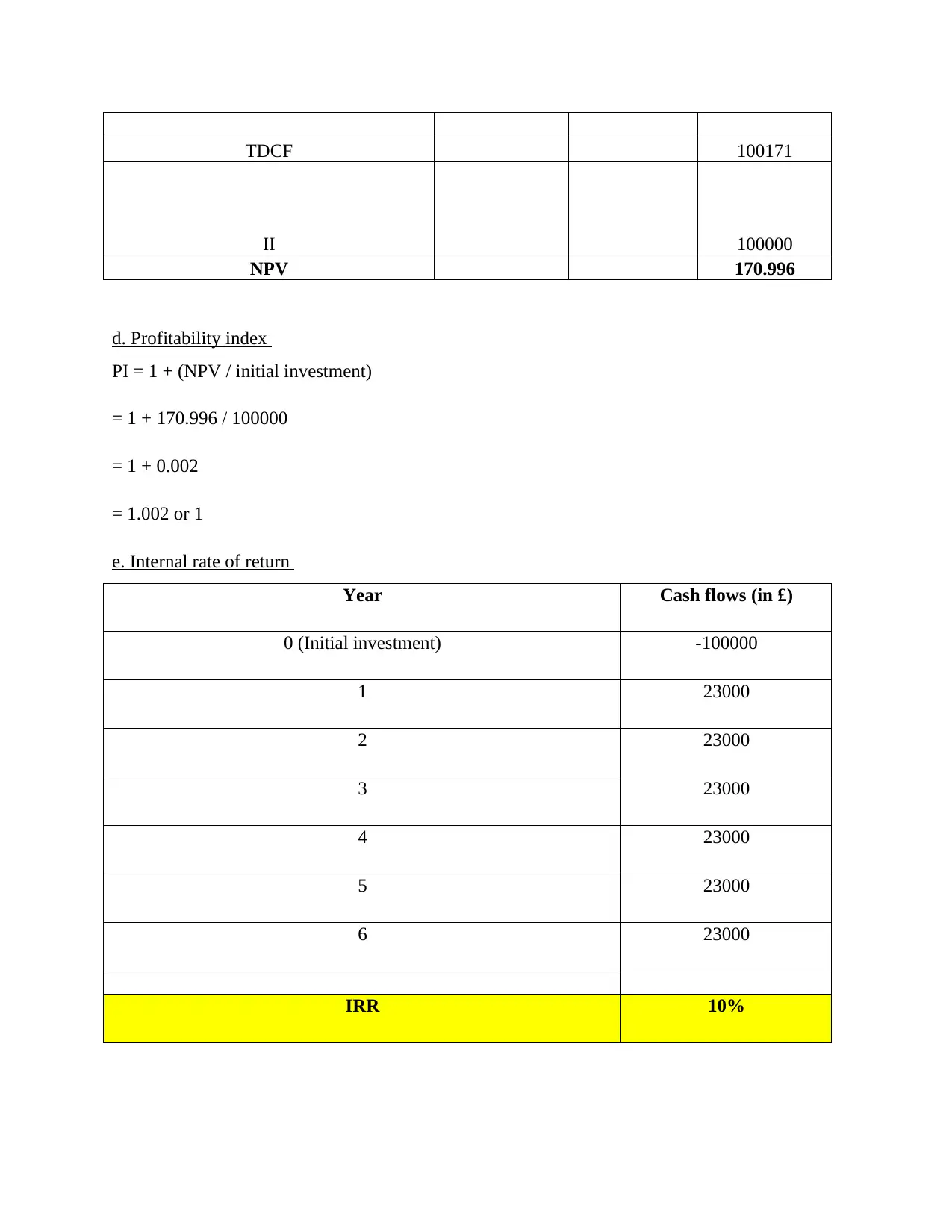
TDCF 100171
II 100000
NPV 170.996
d. Profitability index
PI = 1 + (NPV / initial investment)
= 1 + 170.996 / 100000
= 1 + 0.002
= 1.002 or 1
e. Internal rate of return
Year Cash flows (in £)
0 (Initial investment) -100000
1 23000
2 23000
3 23000
4 23000
5 23000
6 23000
IRR 10%
II 100000
NPV 170.996
d. Profitability index
PI = 1 + (NPV / initial investment)
= 1 + 170.996 / 100000
= 1 + 0.002
= 1.002 or 1
e. Internal rate of return
Year Cash flows (in £)
0 (Initial investment) -100000
1 23000
2 23000
3 23000
4 23000
5 23000
6 23000
IRR 10%
Paraphrase This Document
Need a fresh take? Get an instant paraphrase of this document with our AI Paraphraser
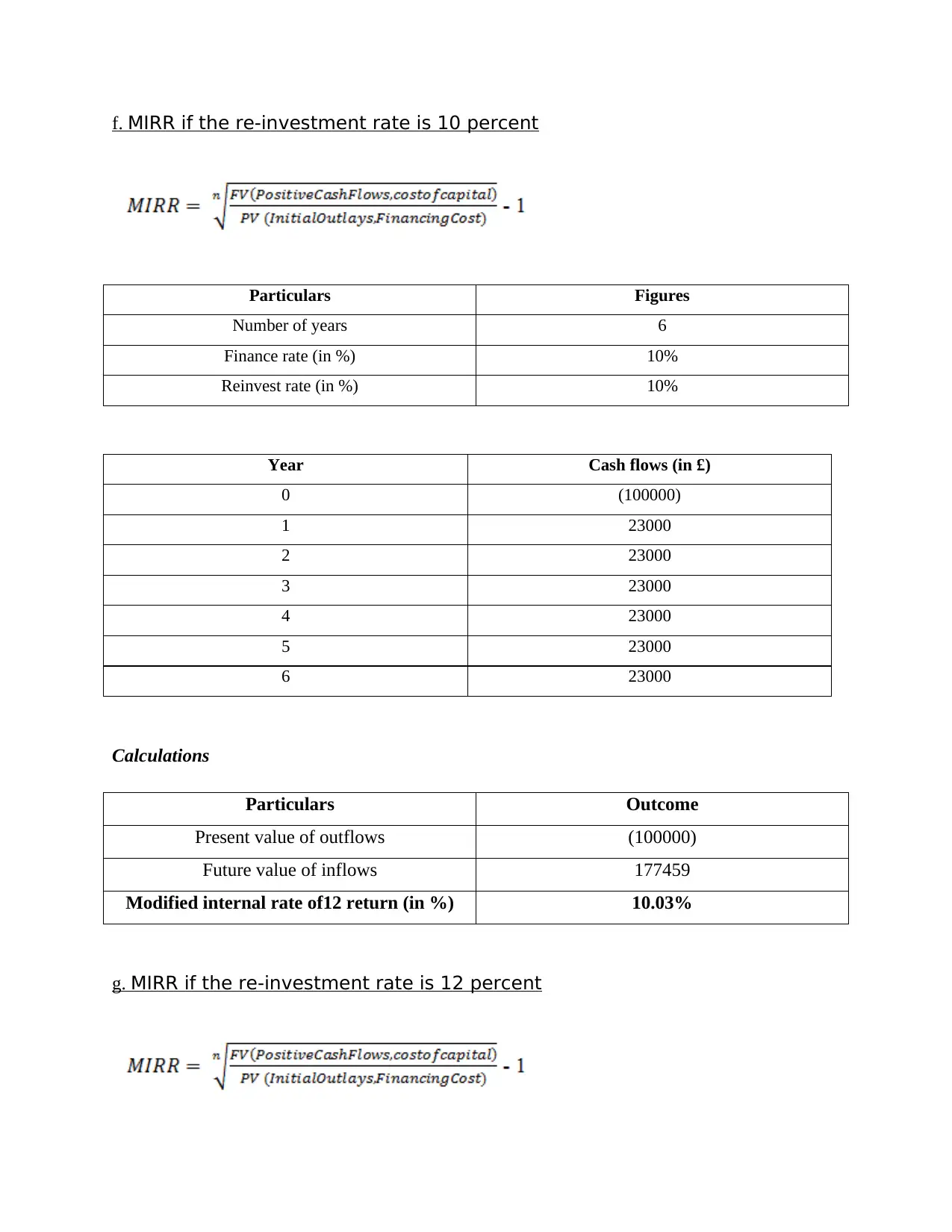
f. MIRR if the re-investment rate is 10 percent
Particulars Figures
Number of years 6
Finance rate (in %) 10%
Reinvest rate (in %) 10%
Year Cash flows (in £)
0 (100000)
1 23000
2 23000
3 23000
4 23000
5 23000
6 23000
Calculations
Particulars Outcome
Present value of outflows (100000)
Future value of inflows 177459
Modified internal rate of12 return (in %) 10.03%
g. MIRR if the re-investment rate is 12 percent
Particulars Figures
Number of years 6
Finance rate (in %) 10%
Reinvest rate (in %) 10%
Year Cash flows (in £)
0 (100000)
1 23000
2 23000
3 23000
4 23000
5 23000
6 23000
Calculations
Particulars Outcome
Present value of outflows (100000)
Future value of inflows 177459
Modified internal rate of12 return (in %) 10.03%
g. MIRR if the re-investment rate is 12 percent
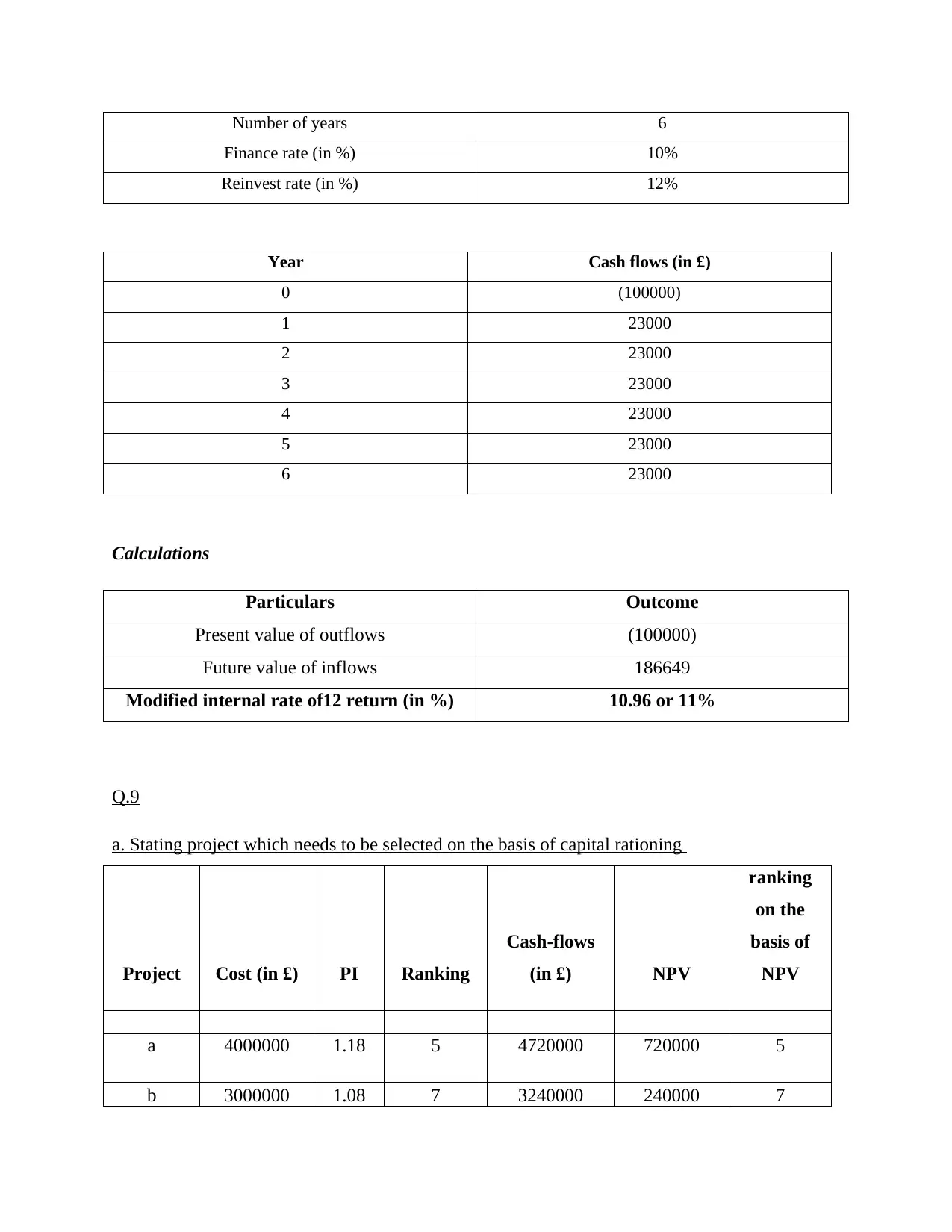
Number of years 6
Finance rate (in %) 10%
Reinvest rate (in %) 12%
Year Cash flows (in £)
0 (100000)
1 23000
2 23000
3 23000
4 23000
5 23000
6 23000
Calculations
Particulars Outcome
Present value of outflows (100000)
Future value of inflows 186649
Modified internal rate of12 return (in %) 10.96 or 11%
Q.9
a. Stating project which needs to be selected on the basis of capital rationing
Project Cost (in £) PI Ranking
Cash-flows
(in £) NPV
ranking
on the
basis of
NPV
a 4000000 1.18 5 4720000 720000 5
b 3000000 1.08 7 3240000 240000 7
Finance rate (in %) 10%
Reinvest rate (in %) 12%
Year Cash flows (in £)
0 (100000)
1 23000
2 23000
3 23000
4 23000
5 23000
6 23000
Calculations
Particulars Outcome
Present value of outflows (100000)
Future value of inflows 186649
Modified internal rate of12 return (in %) 10.96 or 11%
Q.9
a. Stating project which needs to be selected on the basis of capital rationing
Project Cost (in £) PI Ranking
Cash-flows
(in £) NPV
ranking
on the
basis of
NPV
a 4000000 1.18 5 4720000 720000 5
b 3000000 1.08 7 3240000 240000 7
⊘ This is a preview!⊘
Do you want full access?
Subscribe today to unlock all pages.

Trusted by 1+ million students worldwide
1 out of 17
Related Documents
Your All-in-One AI-Powered Toolkit for Academic Success.
+13062052269
info@desklib.com
Available 24*7 on WhatsApp / Email
![[object Object]](/_next/static/media/star-bottom.7253800d.svg)
Unlock your academic potential
Copyright © 2020–2025 A2Z Services. All Rights Reserved. Developed and managed by ZUCOL.


